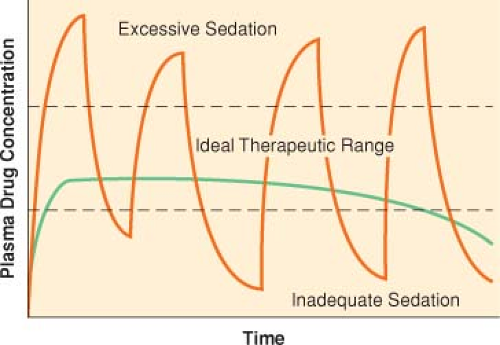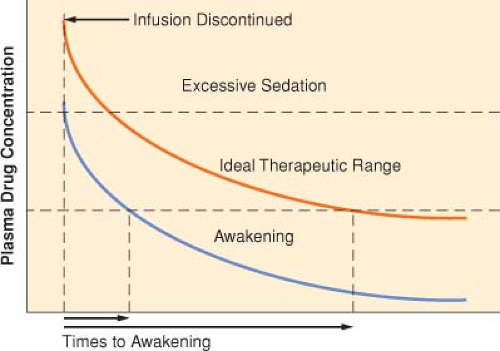Monitored Anesthesia Care
During monitored anesthesia care (MAC), the continuous attention of the anesthesiologist is directed at optimizing patient comfort and safety (Hillier SC, Mazurek MS, Havidich JE. Monitored anesthesia care. In: Barash PG, Cullen BF, Stoelting RK, Cahalan MK, Ortega R, Stock MC, eds. Clinical Anesthesia. Philadelphia: Lippincott Williams & Wilkins; 2013:824–843).
I. Terminology
It is important to distinguish between the terms monitored anesthesia care and sedation/analgesia. MAC implies the potential for a deeper level of sedation than that provided by sedation/analgesia and is always administered by an anesthesiologist provider. The standards for preoperative evaluation and intraoperative monitoring and the continuous presence of a member of the anesthesia care team are no different from those for general or regional anesthesia. Conceptually, MAC is attractive because it should invoke less physiologic disturbance and allow a more rapid recovery than general anesthesia.
II. Preoperative Assessment
The preoperative assessment of a patient scheduled for surgery under MAC should be as comprehensive as that performed before a general or regional anesthetic is administered. Additional considerations in the preoperative assessment of a patient scheduled to undergo MAC include evaluation of the patient’s ability to remain immobile and cooperative. Verbal communication between the anesthesiologist and patient is important in order to evaluate the level of sedation, reassure the patient, and provide a mechanism when the patient is required to cooperate. The presence of a persistent cough may make it difficult for the patient to remain immobile (attempts to attenuate the cough with sedation are not likely to be successful). Additionally, orthopnea may make it impossible for the patient to lie flat.
III. Techniques of Monitored Anesthesia Care
A variety of medications are commonly administered during MAC with the desired end points of providing patient comfort, maintaining cardiorespiratory stability, improving operating conditions, and preventing recall of unpleasant perioperative events.
MAC usually involves intravenous (IV) administration of drugs with anxiolytic, hypnotic, analgesic, and amnestic properties either alone or as a supplement to a local or regional anesthetic.
The drug(s) selected should allow rapid and complete recovery with a minimal incidence of nausea and vomiting or residual cardiorespiratory depression.
A level of sedation that allows verbal communication is optimal for the patient’s comfort and safety. If the level of sedation is deepened to the extent that verbal communication is lost, most of the advantages of MAC are also lost, and the risks of the technique approach those of general anesthesia with an unprotected and uncontrolled airway.
Increased patient agitation may be a result of pain or anxiety (Table 29-1).
Table 29-1 Causes of Patient Agitation During Monitored Anesthesia Care | ||
|---|---|---|
|
IV. Pharmacologic Basis of Monitored Anesthesia Care Techniques: Optimizing Drug Administration
The ability to predict the effects of drugs demands an understanding of their pharmacokinetic and pharmacodynamic properties (context-sensitive half-time, effect site equilibration time, drug interactions).
To avoid excessive levels of sedation, drugs should be titrated in increments rather than administered in larger doses according to predetermined notions of efficacy.
Continuous infusions (e.g., propofol) are superior to intermittent bolus dosing because they produce less fluctuation in drug concentration, thus reducing the number of episodes of inadequate or excessive sedation and contributing to a more prompt recovery (Fig. 29-1).
V. Distribution, Elimination, Accumulation, and Duration of Action
After administration of IV drugs, the immediate distribution phase causes a rapid decrease in plasma levels as the drug is quickly transported to the vessel-rich group of rapidly equilibrating tissues. Accumulation of drug in poorly perfused tissues during prolonged IV infusion may contribute to delayed recovery when the drug is released back into the central compartment after drug administration is discontinued.
Elimination half-life is often cited as a determinant of a drug’s duration of action, when it is actually often difficult to predict the clinical duration of action from this value.
The elimination half-life represents a single-compartment model in which elimination is the only process that can alter drug concentration.
Most drugs used by anesthesiologists for MAC are lipophilic and much more suited to multicompartmental modeling than single-compartment modeling. In multicompartmental models, the metabolism and excretion of some IV drugs may make only a minor contribution to changes in plasma concentration compared with the effects of intercompartmental distribution.
Context-sensitive half-time is the time required for the plasma drug concentration to decline by 50% after an IV infusion of a particular duration is terminated. It is calculated by computer simulation of multicompartmental pharmacokinetic models of drug disposition.
The context-sensitive half-time increases as the duration of the infusion increases (particularly for fentanyl and thiopental).
This confirms that thiopental is not an ideal drug for continuous infusion during ambulatory procedures.
The context-sensitive half-time of propofol is prolonged to a minimal extent as the infusion duration increases. (After the infusion ends, the drug that returns to the plasma from the peripheral compartments is rapidly cleared by metabolic processes and is therefore not available to slow the decay in plasma levels.)
The context-sensitive half-times of drugs bear no constant relationship to their elimination half-times.
How Does the Context-Sensitive Half-Time Relate to the Time to Recovery? The context-sensitive half-time does not directly describe how long it will take for the patient to recover from sedation/analgesia but rather how long it will take for the plasma concentration or drug to decrease by 50%. The time to recovery depends on how far the plasma concentration must decrease to reach levels compatible with awakening (Fig. 29-2).
Effect site equilibration describes the time from rapid IV administration of a drug until its clinical effect is manifest. (A delay occurs because the blood is not usually the site of action but is merely the route via which the drug reaches its effect site.)
Thiopental, propofol, and alfentanil have a short effect site equilibration times compared with midazolam, sufentanil, and fentanyl. This is an important consideration when determining bolus spacing of doses.
A distinct time lag between the peak serum fentanyl concentration (which is an important consideration when determining bolus spacing of doses) and the peak electroencephalographic (EEG) slowing can be seen, but after administration of alfentanil, the EEG spectral edge changes closely parallel serum concentrations. If an opioid is required to blunt the response to a single, brief stimulus, alfentanil might represent a more logical choice than fentanyl.
VI. Drug Interactions in Monitored Anesthesia Care
No one inhaled or IV drug can provide all the components of MAC. Patient comfort is usually maintained by a combination of drugs that act synergistically to enable reductions in the dose requirements of individual drugs.
It is likely that a rapid recovery in the ambulatory setting can be achieved by using an opioid in combination with other drugs (especially a benzodiazepine) rather than using an opioid as the sole anesthetic.
Opioid and benzodiazepine combinations are frequently used to achieve the components of hypnosis, amnesia, and analgesia.
The opioid–benzodiazepine combination displays marked synergism in producing hypnosis. This synergism also extends to unwanted effects of these drugs. (Whereas midazolam alone produces no significant effects on ventilation, the combination with fentanyl produces apnea in many patients.)
The advantage of synergy between opioids and benzodiazepines should be carefully weighed against the disadvantages of the potential adverse effect of this drug combination on the cardiovascular system and breathing.
VII. Specific Drugs Used During Monitored Anesthesia Care (Table 29-2)
Propofol has many of the ideal properties of a sedative–hypnotic for use in sedation/analgesia.
The context-sensitive half-time of propofol remains short even after prolonged IV infusions (in contrast to midazolam), and the short effect site equilibration time makes propofol an easily titratable drug that has an excellent recovery profile.
Stay updated, free articles. Join our Telegram channel

Full access? Get Clinical Tree








